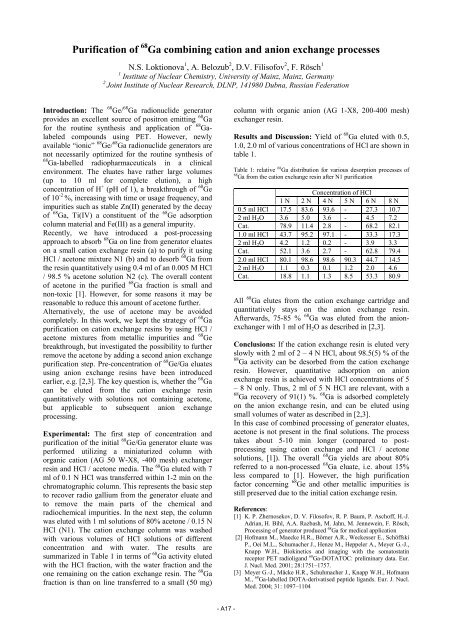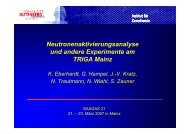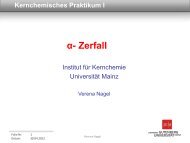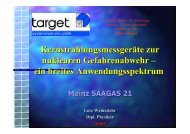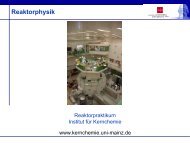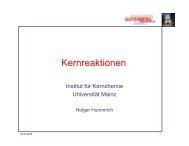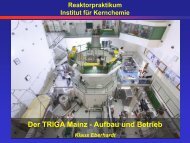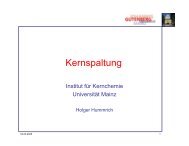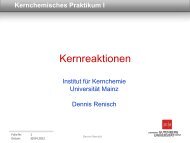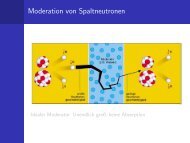jahresbericht 2007 - Institut für Kernchemie - Johannes Gutenberg ...
jahresbericht 2007 - Institut für Kernchemie - Johannes Gutenberg ...
jahresbericht 2007 - Institut für Kernchemie - Johannes Gutenberg ...
You also want an ePaper? Increase the reach of your titles
YUMPU automatically turns print PDFs into web optimized ePapers that Google loves.
Purification of 68 Ga combining cation and anion exchange processes<br />
N.S. Loktionova 1 , A. Belozub 2 , D.V. Filisofov 2 , F. Rösch 1<br />
1 <strong>Institut</strong>e of Nuclear Chemistry, University of Mainz, Mainz, Germany<br />
2 Joint <strong>Institut</strong>e of Nuclear Research, DLNP, 141980 Dubna, Russian Federation<br />
Introduction: The 68 Ge/ 68 Ga radionuclide generator<br />
provides an excellent source of positron emitting 68 Ga<br />
for the routine synthesis and application of 68 Galabeled<br />
compounds using PET. However, newly<br />
available “ionic” 68 Ge/ 68 Ga radionuclide generators are<br />
not necessarily optimized for the routine synthesis of<br />
68 Ga-labelled radiopharmaceuticals in a clinical<br />
environment. The eluates have rather large volumes<br />
(up to 10 ml for complete elution), a high<br />
concentration of H + (pH of 1), a breakthrough of 68 Ge<br />
of 10 -2 %, increasing with time or usage frequency, and<br />
impurities such as stable Zn(II) generated by the decay<br />
of 68 Ga, Ti(IV) a constituent of the 68 Ge adsorption<br />
column material and Fe(III) as a general impurity.<br />
Recently, we have introduced a post-processing<br />
approach to absorb 68 Ga on line from generator eluates<br />
on a small cation exchange resin (a) to purify it using<br />
HCl / acetone mixture N1 (b) and to desorb 68 Ga from<br />
the resin quantitatively using 0.4 ml of an 0.005 M HCl<br />
/ 98.5 % acetone solution N2 (c). The overall content<br />
of acetone in the purified 68 Ga fraction is small and<br />
non-toxic [1]. However, for some reasons it may be<br />
reasonable to reduce this amount of acetone further.<br />
Alternatively, the use of acetone may be avoided<br />
completely. In this work, we kept the strategy of 68 Ga<br />
purification on cation exchange resins by using HCl /<br />
acetone mixtures from metallic impurities and 68 Ge<br />
breakthrough, but investigated the possibility to further<br />
remove the acetone by adding a second anion exchange<br />
purification step. Pre-concentration of 68 Ge/Ga eluates<br />
using anion exchange resins have been introduced<br />
earlier, e.g. [2,3]. The key question is, whether the 68 Ga<br />
can be eluted from the cation exchange resin<br />
quantitatively with solutions not containing acetone,<br />
but applicable to subsequent anion exchange<br />
processing.<br />
Experimental: The first step of concentration and<br />
purification of the initial 68 Ge/Ga generator eluate was<br />
performed utilizing a miniaturized column with<br />
organic cation (AG 50 W-X8, -400 mesh) exchanger<br />
resin and HCl / acetone media. The 68 Ga eluted with 7<br />
ml of 0.1 N HCl was transferred within 1-2 min on the<br />
chromatographic column. This represents the basic step<br />
to recover radio gallium from the generator eluate and<br />
to remove the main parts of the chemical and<br />
radiochemical impurities. In the next step, the column<br />
was eluted with 1 ml solutions of 80% acetone / 0.15 N<br />
HCl (N1). The cation exchange column was washed<br />
with various volumes of HCl solutions of different<br />
concentration and with water. The results are<br />
summarized in Table 1 in terms of 68 Ga activity eluted<br />
with the HCl fraction, with the water fraction and the<br />
one remaining on the cation exchange resin. The 68 Ga<br />
fraction is than on line transferred to a small (50 mg)<br />
column with organic anion (AG 1-X8, 200-400 mesh)<br />
exchanger resin.<br />
Results and Discussion: Yield of 68 Ga eluted with 0.5,<br />
1.0, 2.0 ml of various concentrations of HCl are shown in<br />
table 1.<br />
Table 1: relative 68 Ga distribution for various desorption processes of<br />
68 Ga from the cation exchange resin after N1 purification<br />
Concentration of HCl<br />
1 N 2 N 4 N 5 N 6 N 8 N<br />
0.5 ml HCl 17.5 83.6 93.6 - 27.3 10.7<br />
2 ml H 2 O 3.6 5.0 3.6 - 4.5 7.2<br />
Cat. 78.9 11.4 2.8 - 68.2 82.1<br />
1.0 ml HCl 43.7 95.2 97.1 - 33.3 17.3<br />
2 ml H 2 O 4.2 1.2 0.2 - 3.9 3.3<br />
Cat. 52.1 3.6 2.7 - 62.8 79.4<br />
2.0 ml HCl 80.1 98.6 98.6 90.3 44.7 14.5<br />
2 ml H 2 O 1.1 0.3 0.1 1.2 2.0 4.6<br />
Cat. 18.8 1.1 1.3 8.5 53.3 80.9<br />
All 68 Ga elutes from the cation exchange cartridge and<br />
quantitatively stays on the anion exchange resin.<br />
Afterwards, 75-85 % 68 Ga was eluted from the anionexchanger<br />
with 1 ml of H 2 O as described in [2,3].<br />
Conclusions: If the cation exchange resin is eluted very<br />
slowly with 2 ml of 2 – 4 N HCl, about 98.5(5) % of the<br />
68 Ga activity can be desorbed from the cation exchange<br />
resin. However, quantitative adsorption on anion<br />
exchange resin is achieved with HCl concentrations of 5<br />
– 8 N only. Thus, 2 ml of 5 N HCl are relevant, with a<br />
68 Ga recovery of 91(1) %. 68 Ga is adsorbed completely<br />
on the anion exchange resin, and can be eluted using<br />
small volumes of water as described in [2,3].<br />
In this case of combined processing of generator eluates,<br />
acetone is not present in the final solutions. The process<br />
takes about 5-10 min longer (compared to postprecessing<br />
using cation exchange and HCl / acetone<br />
solutions, [1]). The overall 68 Ga yields are about 80%<br />
referred to a non-processed 68 Ga eluate, i.e. about 15%<br />
less compared to [1]. However, the high purification<br />
factor concerning 68 Ge and other metallic impurities is<br />
still preserved due to the initial cation exchange resin.<br />
References:<br />
[1] K. P. Zhernosekov, D. V. Filosofov, R. P. Baum, P. Aschoff, H.-J.<br />
Adrian, H. Bihl, A.A. Razbash, M. Jahn, M. Jennewein, F. Rösch,<br />
Processing of generator produced 68 Ga for medical application<br />
[2] Hofmann M., Maecke H.R., Börner A.R., Weckesser E., Schöffski<br />
P., Oei M.L., Schumacher J., Henze M., Heppeler A., Meyer G.-J.,<br />
Knapp W.H., Biokinetics and imaging with the somatostatin<br />
receptor PET radioligand 68 Ga-DOTATOC: preliminary data. Eur.<br />
J. Nucl. Med. 2001; 28:1751–1757.<br />
[3] Meyer G.-J., Mäcke H.R., Schuhmacher J., Knapp W.H., Hofmann<br />
M., 68 Ga-labelled DOTA-derivatised peptide ligands. Eur. J. Nucl.<br />
Med. 2004; 31: 1097–1104<br />
- A17 -


